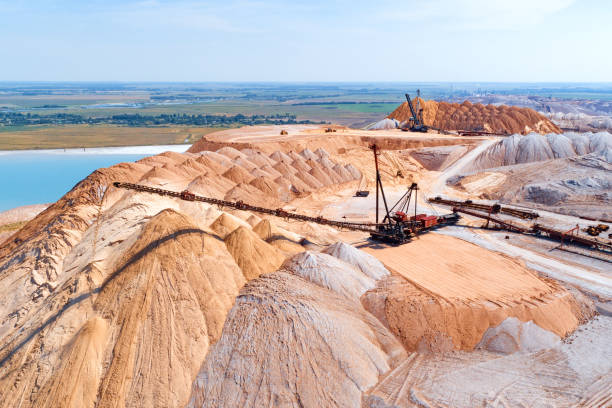Insights into Modern Phosphate Mining

Q1. Could you start by giving us a brief overview of your professional journey in mining and minerals, particularly focusing on your experience in phosphate operations and beneficiation processes?
My educational background includes an M.Sc. in Geology and an M.Sc. in Mining Engineering. I began my career as a senior geologist, primarily specializing in phosphate and oil shale. Later, I served as the manager of Israel's largest phosphate mine. My subsequent role was as an R&D manager, focusing mainly on phosphate beneficiation in both dry and wet processes. I then became the production site manager for a phosphate mine and beneficiation plant utilizing reverse flotation processes. Following that, I joined an international business development team, where I was responsible for geology, mining, and beneficiation. I possess a comprehensive understanding of the global phosphate industry and its key players, and I have also worked as a business intelligence manager. As a freelancer, I have advised phosphate and potash plants in Russia, Brazil, and Israel, helping to improve their beneficiation processes. Additionally, I have substantial experience with limestone quarries, silica sands, and oil shale.
Q2. Mining companies face scrutiny from governments, communities, and investors. What approaches or practices have you seen that help companies maintain their reputation and credibility over time?
While I was a team member rather than a leader in these areas, I observed that community involvement is highly valuable and significantly contributes to the acceptance of mining companies within local communities. Maintaining positive relationships also has a strong influence on governmental decision-making. Honesty and reliability are essential, especially when addressing adverse events, such as environmental incidents.
Q3. Which specific technologies are currently driving improvements in mining operations, safety, and efficiency in phosphate and industrial mineral production?
Mining operations are generally conservative, with improvements tending to be incremental rather than revolutionary. The primary advancements are related to equipment, which has become larger, stronger, more efficient, and consequently more expensive. Effective team coordination is also a critical professional aspect that demands significant experience.
Beneficiation processes are similarly conservative, yet continual advancements are being made, particularly in flotation technology. Innovations such as new cell designs, improved flotation columns, and enhanced reagents have enabled more effective separation at the micron scale. Plant safety is improving due to the adoption of advanced safety methodologies and, as a secondary benefit, the implementation of remote-control technologies, including sensors, cameras, and automated systems.
Q4. Phosphates are crucial for global agriculture and food security. From your experience, what trends are shaping the future of phosphate mining and beneficiation, and how are companies ensuring stable supply?
Approximately 75–80% of the world's P2O5 reserves are located in Morocco. Most countries with significant phosphate reserves, such as the USA, Russia, and China, do not export phosphate either as raw materials or finished products; instead, they are major consumers and, in some cases, importers of phosphate products. Morocco and Saudi Arabia have emerged as the largest suppliers globally. Producers are focusing on improving mining and beneficiation efficiency, as well as utilizing lower-grade materials. There is also a trend toward selling more advanced and specialized products—such as fertilizers, white phosphoric acid, and specialty chemicals—rather than exporting raw phosphate rock or unprocessed phosphoric acid.
Q5. In your experience, what operational metrics or key performance indicators are most critical for ensuring profitability and efficiency in phosphate and industrial mineral production?
The primary expenses in mining are human resources, energy, and maintenance. Reducing these costs directly increases profitability. This can be achieved by utilizing larger equipment, such as bigger trucks and excavators. Maintenance costs can be minimized through immediate parts availability, higher-quality components, a professional workforce, and planned maintenance programs. Energy costs, whether for fuel or electricity, can be reduced by employing modern, efficient engines.
In beneficiation plants, efficiency is enhanced by minimizing fines losses through the use of numerous small hydrocyclones, which can now make separations as fine as 5 microns. Coarse materials are crushed and ground in closed circuits to maximize the extraction of target minerals. The implementation of new technologies—such as advanced flotation cells and columns, innovative reagents, and effective maintenance—also contributes to improved recovery rates.
Q6. With sustainability and environmental impact becoming central to mining operations, what innovations or practices are companies adopting to reduce their ecological footprint?
Environmental impact is a major concern that is increasingly shaping the mineral industry. In mining operations, the adoption of environmentally friendly engines helps reduce pollution, while regular road maintenance lowers dust emissions. The use of long-life tires and better-controlled blasting techniques also contribute to minimizing dust and environmental disturbance.
Beneficiation processes can be modified to reduce environmental impact. For example, replacing calcination—which generates significant pollution—with flotation technology, as implemented by ICL, has proven effective. Lowering combustion temperatures can help eliminate CO2 emissions. Other practices include recycling industrial water, constructing modern, well-sealed ponds to prevent leaks, and reducing dust emissions from crushers, conveyors, and trippers through the use of covers and dust suppression systems. Additionally, using less abrasive acids and finding productive uses for waste—such as as fill material or in concrete production—further lessens the ecological footprint.
Q7. If you were advising investors looking at opportunities in industrial minerals like phosphates, silica sands, or oil shale, what key factors should they consider to assess long-term value and sustainability?
First and foremost, ample reserves that support at least 30 years of production are essential, given the significant investment required. Location is also a critical factor, as are robust infrastructure—including roads, energy sources, and water supply—and favourable government regulations. Access to qualified personnel and a strong scientific and technical environment, such as universities and professional institutes, are important. Attractive markets, investment safety, and low insurance premiums are additional key considerations.
Comments
No comments yet. Be the first to comment!
